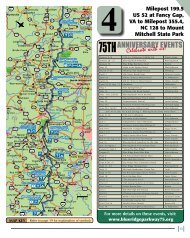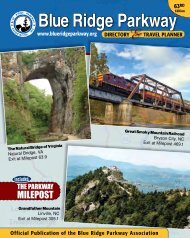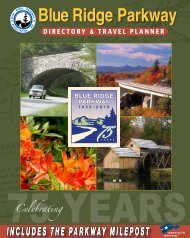Directory
Directory
Directory
- No tags were found...
You also want an ePaper? Increase the reach of your titles
YUMPU automatically turns print PDFs into web optimized ePapers that Google loves.
General Driving SafetyBecause of its unique design, the Parkway drive is differentthan most and this can mean taking some extracare to ensure a safe visit. “Enjoy the view, butwatch the road!” is our way of reminding visitors topay extra attention along the Parkway. A few specificpointers and facts may help even more.Watch out for…STEEP GRADES – In some places, the Parkway has steeper grades thannormally found on highways. Without paying close attention, your speedcan increase far more than you expect.UNFORGIVING ROAD SHOULDERS – The Parkway’s road shouldersare narrow in places so that the meadows or forest edges grow close tothe pavement. This is, of course, part of the beauty of the drive, but mayrequire some extra attention.BUILT-IN DISTRACTIONS – Wildlife, wildflowers, bicyclists, andextraordinary views… all of these contribute to the Parkway experienceand every traveler should be aware of these while enjoying the drive.LIMITED SIGHT DISTANCES – There aren’t many straight lines in thenatural world and the Parkway was designed with gentle curves and notmany straight sections. This is part of what makes the road seem to liegently on the land and it also requires some extra attention while driving.SPEED CHANGES – The Parkway speed limit is mostly 45 mph, butoccasionally you will find yourself in developed areas where the drivingspeed drops to 25 mph.SPIRAL CURVES - Some of the tight curves do not have a consistentradius so extra care needs to be taken, especially on motorcycles.Other Important Safety AdviceHiking shoes or boots are recommended for most trails, especiallythe more strenuous ones. Steep and rocky areas and slipperystream crossings require extra attention and careful footing. Evenfor trails marked “easy,” it is advisable to wear flat or rubber-soledshoes for comfort and good traction. Wearing sandals, “flip-flops,”or high heels can result in accidents.Lock valuables in the trunk of your car or take them with you.Sudden changes in weather are common in these mountains.Even in mild seasons, rapid dips in temperature and unexpectedthunderstorms frequently occur, and at higher elevations the windand temperature can carry a surprising chill. Be prepared forweather changes by bringing along suitable clothing.Do not drink the water from streams or springs.While most visitors travel the Parkway in an automobile, everincreasing numbers visit the park on two-wheels, via bicycle ormotorcycle. Remember, spectacular views are best enjoyed at one of theParkway’s many overlooks.Be aware of rapidly changing road character and environmentalconditions, particularly when the roadway curves and descends at thesame time. Please enjoy the views, but watch the curves.Enjoy theView - Watchthe Road6 THE PARKWAY MILEPOSTLodging & DiningLodges are located on theParkway at Peaks of Otter(MP 86) , Doughton Park(MP 241.1), andMt. Pisgah (MP 408),with housekeepingcabins available atRocky Knob (MP 175).Pisgah Inn • TreetopsRestaurants, other facilities and services are available at a number of otherlocations, opening in mid- or late April. See chart on page 7 for details.Check nps.gov/blri for availability of food andlodging during the 2011 season.Special Information:Mileposts:Along the Parkway, you will see numberedmileposts. The zero milepost marker is atRockfish Gap immediately south of ShenandoahNational Park. Each mile is numberedprogressively southward on the Parkway to itssouthernmost entrance at Cherokee.Our SymbolThe National Park Service arrowhead was authorized as theagency’s official emblem by the Secretary of the Interior on July20, 1951. Created in 1949 by Aubrey V. Neasham, a Park Servicehistorian, the insignia was intended to represent several aspects ofthe mission of the National Park Service: Its shape and earth-brownbackground embody our nation’s cultural heritage exemplified inthe parks by archaeology and history. The bison and the sequoiatree (symbols from the first two national parks--Yellowstone andSequoia) represent the diverse natural world ofplants and animals included within the system.The snowcapped mountain and glacierportrayed on the insignia’s horizon and thewhite of the water in its right foregroundsignify the all-important values of sceneryand recreation. The symbol first appearedon a park road sign, then a ranger uniform inSeptember 1952. The icon was registered as anofficial emblem of the Park Service on February9, 1965, by the United States Patent Office.








